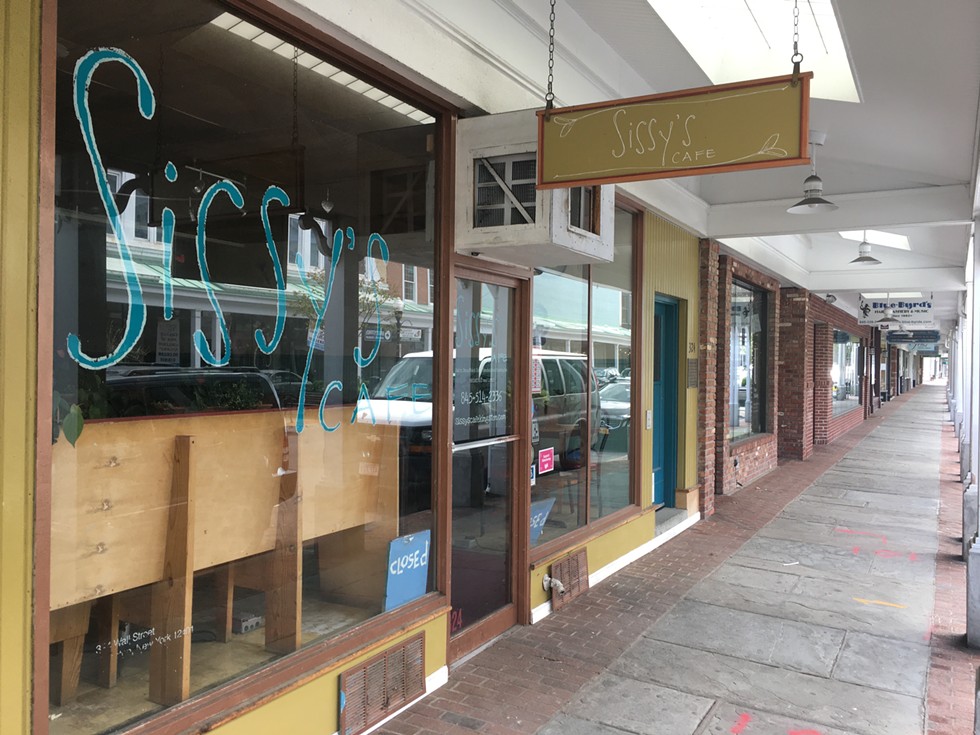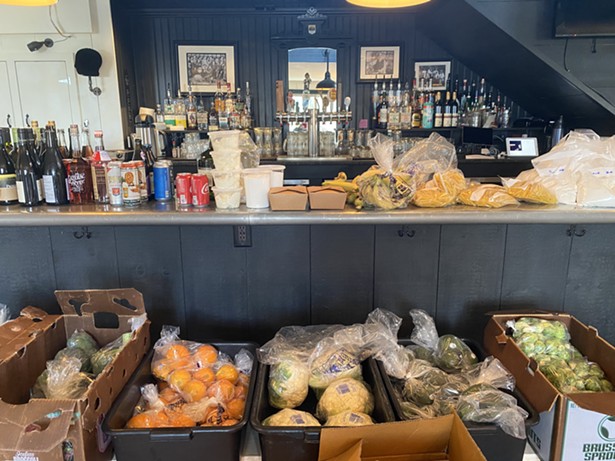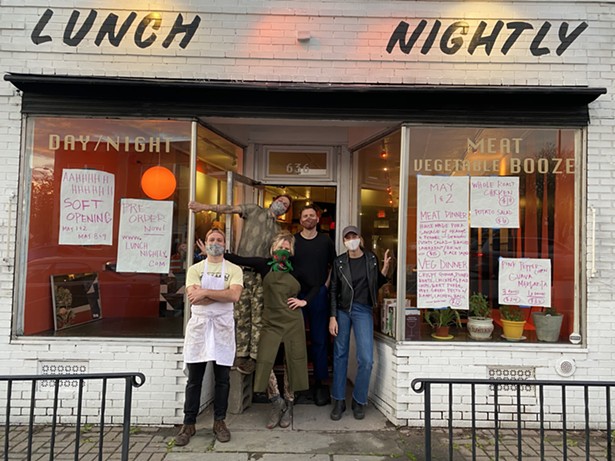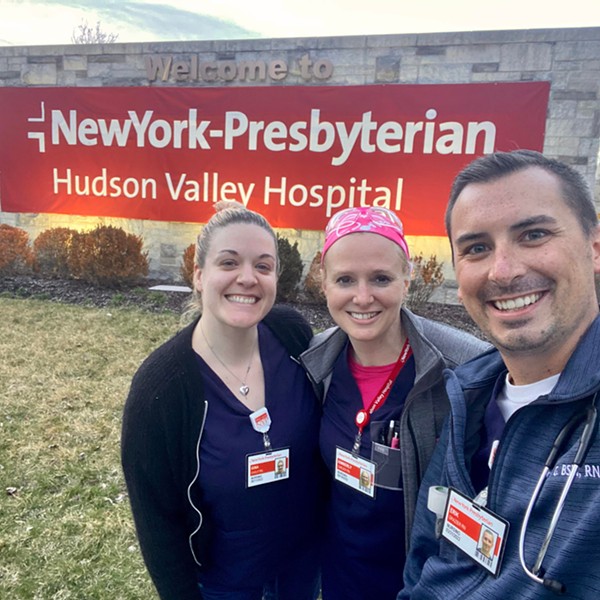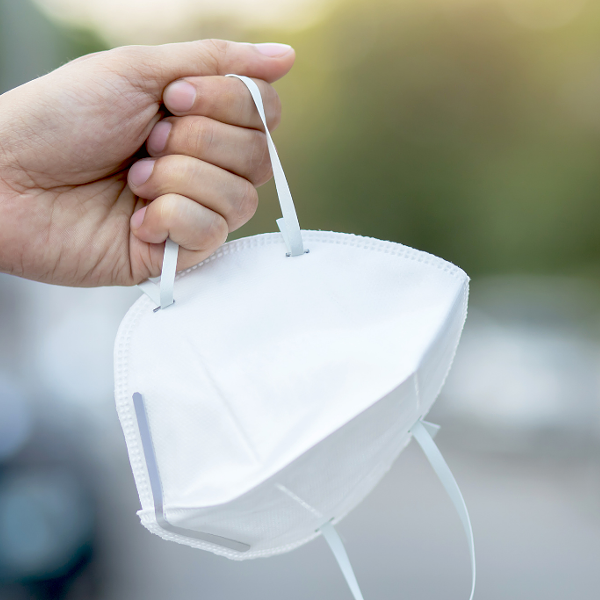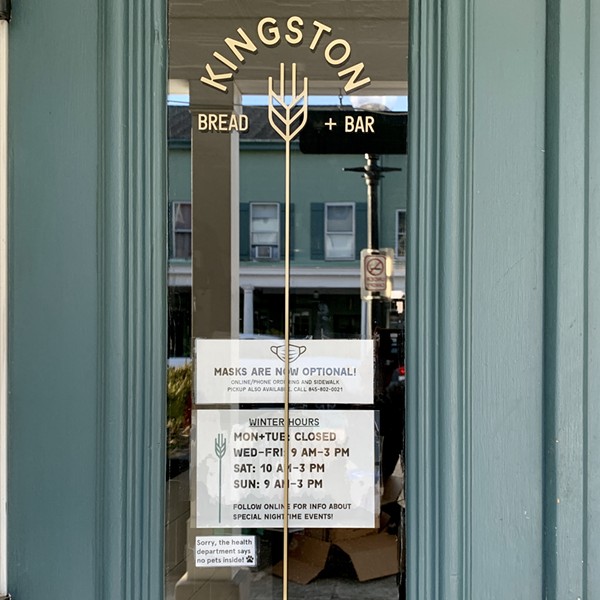On March 18, two days after Governor Andrew Cuomo ordered restaurant dining rooms shut down indefinitely to combat the spread of the coronavirus, Denee Francese-Smith sat alone poring over a ledger, trying to decide what to do next. Francese-Smith and her sister, Shani, opened Sissy’s Cafe in uptown Kingston back in 2011, and had built a solid business serving sandwiches and smoothies to lunchtime crowds of office workers in a neighborhood that is home to the county’s courthouse and main office building, as well as scores of smaller white-collar businesses.
Even before the shutdown, business as Sissy’s began declining as more and more regulars began working from home. Just two days earlier, Francese-Smith had removed tables to comply with an executive order that restaurants reduce capacity by 50 percent to accommodate social distancing. Now, between visits to the US Small Business Association website looking for information on how to get a loan through the $349 billion Paycheck Protection Program, Francese-Smith was scouring the ledger looking for a sliver of hope that the business could get by in a new world of curbside pickup and delivery.
“I want to stay afloat as long as possible for our employees,” Francese-Smith said at the time. “I’m breaking down the numbers, every single thing that goes in or out every day.”
But two days later, the sisters determined that, without the dining room, they could not generate enough income to justify putting in a fresh order with their vendors. So they decided to close Sissy’s. Despite that, Francese-Smith counts herself lucky: With a strong customer base and resources built up over nine years in business, she was confident that the cafe would be back in business one day.
“We will definitely be here on the other side,” she says. “I just feel so deeply for the new restaurants that just opened or are trying to open, and the ones that have been teetering over the winter and kind of wondering what to do, this is probably going to sink them into closing permanently.”
Decisions like the one faced by Francese-Smith have become the new normal in the mid-Hudson Valley—across much of the US, in fact—impacting neighborhood lunch spots; small, chef-owned eateries; and restaurant groups with multiple establishments and hundreds of employees. The pain is made worse by the fact that no one can say when the doors will open again or what will be left when they do.
Eryn Stutts, chef-owner of PAKT in midtown Kingston, says she recognized immediately that her establishment could not survive Cuomo’s shutdown order. Like most restaurants, the Southern-style eatery operated a finely tuned business model without much room for error. That model, Stutts says, was based around a full dining room supplemented by catering and festival jobs. With dining rooms closed and summer events in doubt, Stutts opted to close PAKT's dining room for good. (A limited menu and some pantry items are available to order for pickup or delivery on PAKT's website.) She says that her decision was driven by concern that she would be caught in a situation where she could not pay her employees for hours they had already worked, as well as a general pessimism about the prospects for small independent eateries.
“I realized it early,” says Stutts. “I think a lot of people haven’t realized it yet: The restaurant industry is over.”
***
The past two months have seen a startling reversal for an industry that had become a linchpin of the tourism-based regional economy. Over the past two decades, the Hudson Valley has leveraged its proximity to New York City, its abundance of agricultural resources, and its culinary talent to develop a fine-dining culture built around fresh, local ingredients and farm-to-table experiences. Fine dining, as part of the larger, more traditional food and beverage sector, represents a major regional employment sector. A 2010 report by the Mid-Hudson Regional Economic Development Council found that the food and beverage sector employed 53,000 people in Columbia, Greene, Ulster, Dutchess, Orange, Putnam, Sullivan, Westchester, and Rockland counties, a 23 percent increase from 2000. By 2016, that number had grown to 67,000. The sector is ranked fourth in regional employment statistics, behind health care, government services, and retail. In Ulster County, where some 464 establishments employ 5,162 workers, the food and beverage sector grew by more than 10 percent between 2014 and 2018, growth that wasn’t projected to slow down before the pandemic hit.
According to Melissa Fleischut, president and CEO of the New York State Restaurant Association, sales had already begun to drop in March as more and more New Yorkers began staying home, out of the virus’s path. Then the bottom fell out with Cuomo’s shutdown order. A survey conducted by the association, released on April 21, shows the depth of the hole the industry has found itself in. Statewide restaurants lost $3.6 billion in sales, while 80 percent of the sector’s workforce has been laid off since March. The survey found that overall sales were down 79 percent in the first 10 days of April compared to the same period last year. Forty-nine percent of the 550 New York restaurants surveyed planned to shut down entirely for at least 30 days. Eleven percent reported that they had or would shortly close, with no plans to reopen. Fleischut, meanwhile, said that by her own estimation, 25 to 30 percent of restaurants that close down will never reopen. She believes that many of the association’s members are treading water, getting by on takeout and delivery services that may not be sustainable for long.
“If you don’t have the same volume coming through your restaurant, how do you make enough to make it worthwhile?” she says. “I think a lot of places will eventually decide that takeout and delivery is just not working and they’ll shut down.”
***
The Hyde Park Brewing Company is one of hundreds of Hudson Valley restaurants limping by on curbside pickup until the shutdown is lifted. Angela LoBianco-Barone grew up in a restaurant family and got her start selling pizza at $1 a slice with her brother and business partner, Joey LoBianco. The pair have owned 14 restaurants across the region, opening the Hyde Park Brewing Company in 1994 as pioneers of the craft beer movement. In March, LoBianco-Barone had 28 employees at the establishment; today she has five. The front of the house consists of her and her sister-in-law, who takes orders and runs food out to a table in the parking lot for no-contact pickups.
She used to deal with a number of vendors for product; now there’s just one local company. The orders are smaller, more frequent, and light on fresh produce; with sales down 85 percent, tossing wilted greens because the salad special didn’t sell is no longer an acceptable business expense. The menu has been scaled back and simplified. LoBianco-Barone said that she’s found herself falling back on the lessons taught to her by her father, an 85-year-old Italian immigrant who survived an epidemic as a child and built a thriving restaurant business in America.
“Thank God we’ve been here for 25 years; we have a plan, we know how long we can last,” says LoBianco-Barone. “Just do what you know, and as long as you keep getting a little sandwich and don’t expect the whole table, you’ll be okay.”
For many restaurant owners, reorienting to takeout and delivery is a matter of survival. Restaurants typically run on small profit margins—Fleischut estimates that most of the association’s members operate on margins between three and five percent—and rely on lines of credit with vendors who provide everything from clean linens to ground beef. If a restaurant closes its doors in arrears, those vendors will need to be paid before the restaurant can place new orders to restock and reopen. For businesses that rely on alcohol sales, the situation is even more daunting. According to state liquor authority regulations, businesses that go more than 30 days in arrears with a distributor must be placed on a delinquent list and pay for future orders in cash. Meanwhile, stimulus money obtained through the Paycheck Protection Program can be used for staff costs and a portion of rent and utilities, but not for new stock.
“I can tell you how hard it is to get back open when you close down for a week for vacation,” says Rich Reeve, a chef who, with his wife and business partner, Maya, has owned restaurants in Pine Plains, Poughkeepsie, and Kingston. “I don’t know how it happens at all when you’re shut down for six weeks, eight weeks, however long this is going to be.”
While some owners worry about paying off vendors in order to reopen, others are leveraging relationships with suppliers to forge a new business model: The restaurant as grocery. In Hunter, Kim McGalliard shut Jägerberg, her German beer hall and restaurant, in March after a trial curbside pickup run convinced her that the model was not sustainable.
But she soon realized that her main supplier—New York City-based Baldor Specialty Foods—could offer a lifeline to neighbors who did not want to run the risk of regular trips to the grocery store, or were having trouble finding items like pasta and chicken. The food vendor offered daily deliveries and let owners order in small batches.
The grocery operation, which McGalliard set up last month, allows customers to place an order online on Wednesday night, and deliveries come in on Friday. McGalliard and her remaining kitchen staff package the orders and customers can pick up their groceries Friday afternoon. They also run deliveries to customers in Hunter and West Hurley. McGalliard says that the model is working, in part because the order-in-advance system allows her to purchase exactly what she can sell. Besides maintaining a revenue stream, McGalliard says she hopes the grocery operation will pay dividends once she is able to reopen.
“In this business, word-of-mouth is everything,” says McGalliard. “A lot of our grocery customers didn’t know we were here before. Now I’m hoping that, once this is all over, they’ll actually come in.”
***
With hospitalizations and death rates from the coronavirus dropping, and economic pain deepening, restaurant owners are beginning to seek answers to when and how a reopening might take place. Joe Bonura Jr. is president and CEO of the Bonura Hospitality Group, operator of Shadows on the Hudson in Poughkeepsie and Blue Pointe in Newburgh. Bonura also owns wedding venues, catering halls, and a country club in Orange and Dutchess counties. He has been working with a group of restaurant and catering professionals to develop guidelines on reopening for consideration by state officials.
Bonura, who was forced to lay off 500 employees in March, said that his guidelines include things like reduced capacity to accommodate social distancing, hand-sanitizing stations for customers at the entrance, prework temperature checks for employees, and masks for staff and patrons alike. He believes that at least some of the recommendations could become part of a new normal as the industry and the world awaits a vaccine that could be years away.
“Before 9/11, nobody took their shoes off before they got on a plane; now you don’t even think about it,” says Bonura. “Some of these things will be here to stay, and they’re good things. It will help with the seasonal flu, it will help with the stomach bug that goes around every year. Everyone sanitizing their hands on the way in will just be a normal part of going out.”
Bonura has purchased 20,000 surgical masks for staff and customers in anticipation of an eventual reopening. The guidelines, he says, could provide a roadmap for lawmakers faced with the monumental task of understanding the ins and outs of dozens of economic sectors and what it will take to get them back open safely. (In late April, the National Restaurant Association released its own set of guidelines after consulting with the Food and Drug Administration, public-health officials, and industry experts.)
But Bonura also acknowledges some of the measures needed to reopen the restaurant industry—most notably, the prospect of permanently reduced seating capacity—could provide insurmountable challenges, especially to smaller restaurants with fewer resources. The biggest hurdle facing the industry, he says, is uncertainty.
“We’ve been around for 45 years and we have some resources behind us, but we’re not indestructible. If we’re not able to open, in some capacity, by early June, it is going to be really challenging, even for us.”
That anxiety extends throughout the Hudson Valley’s food sector, from Bonura’s mini-empire to Lunch Nightly, a new Kingston spot whose owners are watching their limited resources dwindle as they remain in limbo after opening during the pandemic. Co-owners Sam Strand, Gabriel Weinstock, and Miles Crettien met while working at Lis Bar, part of midtown Kingston’s expanding nightlife sector. Together they developed a plan for a whole-animal butcher shop and deli by day, which would transform into a bar serving craft cocktails and shared plates at night. By the time the shutdown order arrived, the trio had already recruited chef June Rose from New York City and obtained a lease on the site of a shuttered cafe on Broadway. In March, Weinstock, Strand, and Rose went into self-isolation in an apartment above the restaurant, spending their time honing recipes and finalizing plans in anticipation of opening as scheduled on April 1. With much of their business plan predicated on the butcher shop and deli, the owners figured they would be well positioned to ride out the pandemic. But they found themselves sidelined not by economic hurdles, but a bureaucratic one.
Lunch Nightly needed approval from the Ulster County Health Department to open, but in March, its owners learned that the department was not sending staff out to do inspections. The establishment was locked out of the Paycheck Protection Program and other stimulus funds because it can’t show a revenue stream or payroll costs from 2019; meanwhile, rent and other costs were rapidly draining the pool of money the partners had set aside to ride out their first year in business. On April 15, Strand told Bon Appetit, “We are in a black hole.”
After an informal conversation with health department staff, Strand, Weinstock, and Crettien submitted a “virtual inspection” using photographs of the space, the equipment, and results of various chemical tests used to verify sanitary conditions. On April 23, they finally received their license. Lunch Nightly opened for takeout service on May 1, and “soft opened” its deli and butcher shop on May 15.
“To say we’re in good shape is kind of shaky right now,” says Strand. “But we’re super psyched that now we can do dinners and get food out the door.”
***
Earlier this month, Cuomo unveiled plans for a phased reopening of New York’s economy, including the restaurant sector. The proposal calls for reopening by region based on metrics that include steady declines in new coronavirus infections as well as adequate testing and contact tracing capacity.
Under Cuomo’s plan, restaurant dining rooms would be allowed to reopen in Phase Three, after construction, manufacturing, retail, and professional services, and before schools, theaters, and other entertainment venues. Locally, officials from six mid-Hudson counties have convened a regional task force to coordinate efforts to implement the reopening plan. While the news offers a glimmer of hope for restaurant owners, uncertainty lingers. New York’s State of Emergency will remain in effect until at least June 7, and there is no actual timeline for reopening.
Meanwhile, owners are left to wonder whether reopening will make financial sense with social-distancing guidelines in place and the looming threat of a second wave of infections leading to another shutdown. A nationwide survey by the restaurant industry data firm Black Box Intelligence indicated that sales were up last week between eight and 15 percent in full-service restaurants that have reopened their dining rooms. But dine-in sales represent just 13 percent of total sales in those restaurants, compared to 88 percent over the last year.
Denee Francese-Smith says she and her sister were weighing reopening Sissy’s as a takeout operation using PPP funds and a disaster-relief loan. Francese-Smith says that she missed the first round of funding by a few hours after a process she described as “insane.” She checked with her bank on a Friday and was told that the applications weren’t ready yet. When she checked back on Sunday, the funds were gone. She was luckier with the second round of funding. The money, she says, she will help her pay staff salaries and reopen. But, in a concern echoed by other owners, Francese-Smith said that the $600 stimulus bonus tacked onto the unemployment checks of laid-off employees would make staffing difficult: Many restaurant workers, especially lower-paid kitchen staff, might decide that it makes more economic sense to stay home than return to work given the industry’s uncertain future.
“I can’t compete with that,” says Francese-Smith. “I’m lucky, I have a very loyal staff that actually likes working here. But if someone didn’t like their job in the first place, they’re not going back.”
Other owners question whether the industry will ever return to “normal” and whether that might be a good thing. Bonura notes that the restaurants have been squeezed for years by declining profit margins. Menu prices, he says, have not kept pace with escalating prices for everything from beer to electricity. Those dynamics are likely to get worse with added costs associated with maintaining the safety of patrons and staff. And while owners acknowledge that the wave of restaurant closures would mean less competition, they fear a similar contraction in their customer base.
“Will people want to go out to restaurants as often as they did? Will they be willing to pay higher prices?” says Bonura. “I don’t have the answer.”
Correction: An earlier version of this story stated that PAKT restaurant closed for good in March. Owner Eryn Stutts does not plan to reopen the dining room, but the restaurant is serving meals to go.







